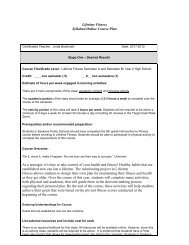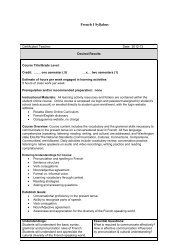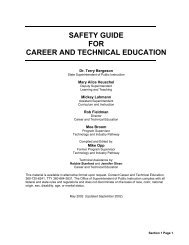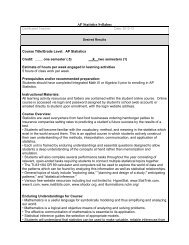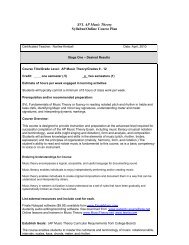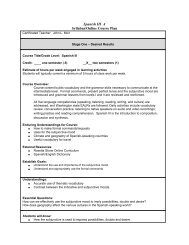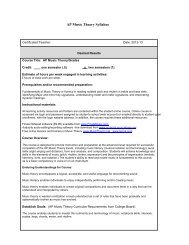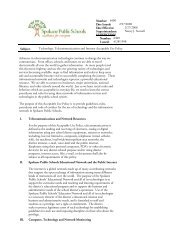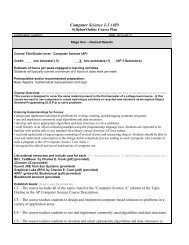Syllabus - Spokane Public Schools
Syllabus - Spokane Public Schools
Syllabus - Spokane Public Schools
Create successful ePaper yourself
Turn your PDF publications into a flip-book with our unique Google optimized e-Paper software.
Japanese 2 <strong>Syllabus</strong>School Year: Click here to enter text.Certificated Teacher:Desired ResultsCourse Title (example: Geometry A and B): Japanese Year 2, A and BCredit: __ __ one semester (.5) __x__ two semesters (1.0)Prerequisites and/or recommended preparation (example: Completion of Algebra 1):Completion of Japanese Year 1Estimate of hours per week engaged in learning activities:Students will typically commit a minimum of 5 hours of class work per week.Instructional Materials:All learning activities (resources, assignments, assessments) are contained within or referenced in thestudent’s online course. The online course is accessed via login and password assigned by student’s school(web account) or emailed directly to student upon enrollment, with the login website.Other resources required/Resource Costs:(Examples: This course requires a MathXL account which will be provided by your course instructor. Holt McDougalGeometry 2011 – online videos, examples, and activities. These additional resources will be provided at no additional cost.OR There are no additional textbooks, materials, or resources required for this course.)All learning activity resources and folders are contained within the student online course. Online course isaccessed via login and password assigned by student’s school (web account) or emailed directly to studentupon enrollment, with the login website address.Rosetta Stone Online Curriculum (http://spokane81.rosettastoneclassroom.com/en-US/)Erin’s Challenge website (https://www.erin.ne.jp/en/) – This is a product and service of The JapanFoundation.Every student will need access to a computer, a mic and headphones set, and some method ofsending digital copies of their work.Course Description:One of the primary focuses of this course is the development of the skills required to properly identify,pronounce and produce the Katakana characters used in the writing of Japanese. All five languagecompetencies (speaking, listening, reading, writing, and culture) are addressed, and Washington StateEALRs are followed. Daily activities include vocabulary review; conversation practice; listening to nativespeakers on audio and video recordings; writing practice and reading comprehension. Course contentincludes the vocabulary and grammar necessary to create sentences including verbs and adjectivesconjugated in their positive, negative, present and past forms. Unit-ending projects will includepreparing mini reports and recorded presentations. Occasional culture-related projects include suchthings as the creation of Japanese style New Years cards. Students will be expected to have andmaintain a portfolio for the class. All students are encouraged to participate in the field trip to theJapanese and American Youth Leadership Conference at Mukogawa Fort Wright Institute in April ($10charge per student to cover the cost of the bus and lunches). Students will be encouraged to write atleast one letter to a Japanese student at MFWI.Enduring Understandings for Course (Performance Objectives):What will students understand (about what big ideas) as a result of the course?• Pronunciation and spelling in Japanese• Ability to identify and produce (in type and print) Katakana characters and an understanding ofhow their usage differs from that of Hiragana and Kanji characters• Fundamental understanding of Japanese sentence structure and the role of particles.• Understanding of the function of counters.
• Understanding of a few key concepts of Japanese culture and how they affect both sentencestructure and communication patterns• Learning vocabulary through context• Pre-reading strategiesEssential Questions:What cultural considerations should be taken into account to improve effectivecommunication?How are moods and ideas expressed through the use of elements of grammar?How do Japanese counting systems differ from those ofEnglish?Why are the reasons for and the benefits of having multiple writing systems?Course Learning Goals (including WA State Standards, Common Core Standards, National Standards):What is the key knowledge and skill needed to develop the desired understandings?Washington State Essential Academic Learning Requirements***See pages 172-192 of Rosetta Stone's WA EALR alignment PDF fileAccurate pronunciation• Writing proficiency in Katakana• Ability to identify several additional Kanji characters (minimum of 60 total)• Ability to identify parts of speech and explain their functions• Ability to identify and explain the functions of markers and particles• Ability to identify and explain the functions of several counters• Ability to accurately state the time• Ability to conjugate verbs in the polite form (including the present positive, present negative,past positive, and past negative)• Ability to conjugate adjectives in the polite form (including the present positive, presentnegative, past positive, and past negative)• Ability to link two sentences together to form complex and compound sentences• Ability to create comparison/contrast sentences including the I rJ: ;V, rJ:J pattern• Ability to properly make requests (both positive and negative), to extend invitations, and tomake suggestions• Ability to nominalize verbs and entire sentences• Ability to report hearsay or to make conjecture• Ability to make and respond to the typical exchanges involved in the purchase of a train ticket• Ability to identify several stores and places in a typical town or city• Ability to use the verbs of existence (imasu & arimasu) in conjunction with prepositions oflocation to state the location of one person or thing in relation to another or others• Ability to properly apply common Japanese greetings and expressions to a variety of everydaysituations• Awareness and appreciation of Japanese cultural differences and their influence oncommunication patternsStudents will know: How to identify and produce Katakana characters and will be able to explain the uses of Katakana. How to identify the different types of adjectives (!-Adjectives & Na-Adjectives). How to describe things and people through the use of adjectives including the linking ofmultiples adjectives. How to conjugate adjectives of both groups to make them negative and/or to put them in thepast tense. How to identify the different groups of verbs (E-1, Regular, and Irregular). How to conjugate verbs back and forth from the polite/Masu-form to the casual/Plain form.
How to conjugate verbs to the Te-form and use it to make requests.How to conjugate verbs to the Nai-form and use it to make negative requests.How to conjugate verbs to the Tai-form to express what one wants to do.How to relate various daily activities and give the time of their occurrence including the use ofadverbs such as 'exactly' and 'about' and various common time expressions.How to incorporate the use of 'sequencers' (sequence adverbs) when listing the occurrence ofseveral events in the course of a day.How to nominalize verbs and sentences using N', No, and Koto.How to lessen the directness and impact of a sentence using 'softeners.'How to identify and explain the functions of several counters.How to create complex and compound sentences using the words 'before,' 'because,' 'but,' and'in order to' to link two events together.How to properly invite and make suggestions.How to purchase a train ticket including the proper responses to the most likely questions.The Japanese names for several common stores and places in a typical town or city, and how tostate the location of one in relation to another using prepositions of location such as 'next to' and'across from.'How to ask and give specific directions to locations around a city.How to report hearsay or that a statement is uncertain/based on appearances.How to identify Kanji pictographs and the elements of which they are comprised.Students will be able to: Write Japanese sentences correctly incorporating the use ofHiragana, Katakana, and Kanjicharacters. Properly combine numbers with the counters appropriate to several categories of nouns. Create complex and compound sentences. Use the Japanese language to accomplish various practical tasks including asking andtelling the time, inviting or suggesting an activity, purchasing a train ticket, and givingsomeone directions to a place across town.Evidence of AssessmentWhat evidence will be collected to determine whether or not the understandings have been developed, the knowledge and skillattained, and the state standards met? [Anchor the work in performance tasks that involve application, supplemented as needed byprompted work, quizzes, observations, and assessments]Performance Tasks:• Formative Oral Assessments• Writing samples• Participation in blogs and forums• Unit tests• Summative projects (Unit Projects)Other Evidence (self-assessments, observations, work samples, quizzes, tests and so on):• Self-assessments• Observation/Activity reports from Rosetta Stone• Online Vocabulary practice games• QuizzesTypes of Learning ActivitiesIndicate from the table below all applicable learning strategies that may be used in the course.Direct InstructionIndirectInstructionExperientialLearningIndependent StudyInteractiveInstruction
___x_StructuredOverview_ _x_ _Minipresentation_ __ _Drill & Practice_ _x__Demonstrations_ __ _Other (List)Other:_ _x_ _Problembased_ __ _Case Studies ___ _Inquiry_ __ _ReflectivePractice_ __ _Project_ __ _Paper_ __ _ConceptMapping_ __ _Other (List)_ __ _ Virt. FieldTrip_ __ Experiments__ _Simulations__x _Games__ _Field Observ._x_ _Role-playing_x_ _Model Bldg.__x _Surveys__ _Other (List)_x_ _Essays_x_ Self-pacedcomputer__ _Journals__x _Learning Logs__ _Reports__ _Directed Study_ __x _ResearchProjects_ __ _Other (List)__x _Discussion__ _Debates__ _Role Playing__ _Panels__ _Peer PartnerLearning__ _Project team__ _Laboratory Groups__ _Think, Pair, Share__ _CooperativeLearning__ _Tutorial Groups__ _Interviewing__ _Conferencing__ _Other (List)Students will participate in a wide variety of learning activities in Black Board and Rosetta Stone, including:• Vocabulary identification/recognition• Slogs• Audio blogs• Audio and video presentations• Reading comprehension activities• Summarizing activities• Self-assessments Performance tasks- presentations, etcLearning ActivitiesLearning activities (as provided in the student friendly course schedule posted in online course) and contains the scope and sequence ofperformance tasks, activities and assessments by semester, unit, and weeks.These learning activities are aligned with the successful completion of the course learning goals andprogress towards these learning activities will be reported monthly on a progress report.Japanese Year 2 Learning ActivitiesStudents will participate in a wide variety of learning activities, including:Interactive audio/video lessonsProblem/Puzzle-solving tasksOnline Blogs, Discussions, and WikisLetter-writingGroup discussionsReading comprehension activitiesStory translating and summarizing tasksShort-essay compositionsTeam projectsThe instruction focuses on combining knowledge of the Japaneselanguage and culture with strategies for effective communication.
Outline of Class Procedure and Activities1. Every week instruction specific to that week’s activities will be given through an instructor’smessage in the Announcements.2. Every student will be engaged in individual study with Rosetta Stone or Erin’s Challengelessons. This is in addition to the other class activities.3. Students will be required to make weekly journal entries reporting on their work for theweek.4. All students will work together to create a class list of vocabulary words and grammarexplanations for the RS/EC lessons.5. Many assignments and projects will be given that students are expected to work togetheron completing. Students can discuss answers to questions among themselves throughchat, texting, blog posts or any other means of collaboration.6. Culture will be a primary consideration in every assignment. Students will learn to speakand write about topics of life in Japan and how they reflect the culture. Different purposesfor writing will be practiced and the students will learn the words and grammar that theyneed to be able to accomplish their objectives.7. All students will be encouraged to set their sights on taking the AP, the JLPT, the ACTFL orother language proficiency test. Samples of the types of questions and tasks will beincluded in the instruction.I. Core Concepts:A. PronunciationB. Reading and Writinga) Katakana alphabetb) second-year KanjiC. Greetings, Culture and Demographicsa) more basic greetings and common phrasesb) more information on Japanese culture and updates on modem developments of interestc) Japanese holidays and festivalsD. Numbers & Countersa) about a dozen additional sets of counters including those involved in the telling of timeE. Modifying Nounsa) modifYing with other nounsb) modifying with !-adjectives (i.e. true adjectives)c) modifYing with Na-adjectivesF. Verb Conjugationa) positive, negative, present, and past of the Plain form and the Masu-formb) Te-form, Nai-form, and Tai-formc) Te-form constructions including the addition of 'kudasai' for making requests and the linking ofsequential activitiesG. Sentence Structurea) placement and usage of adverbs and adjectivesb) placement and usage of multiple markers and particlesc) usage of conjunctions to create complex and compound sentencesH. Sentence Typesa) requestsb) invitationsc) suggestionsd) hearsay and conjectureI. Other Grammara) nominalization
II. VocabularyA. Greetings and Common phrasesB. CountersC. AdjectivesD. VerbsE. Time expressionsF. Vocabulary and expressions involved in the purchasing of a train ticketG. StoresH. Prepositions oflocationI. Expressions involved in asking and giving directionsJ. Holiday terms and expressions
Ill. Washington State Essential Academic Learning Requirements***See pages 172-192 of Rosetta Stone's WA EALR alignment PDF file:



